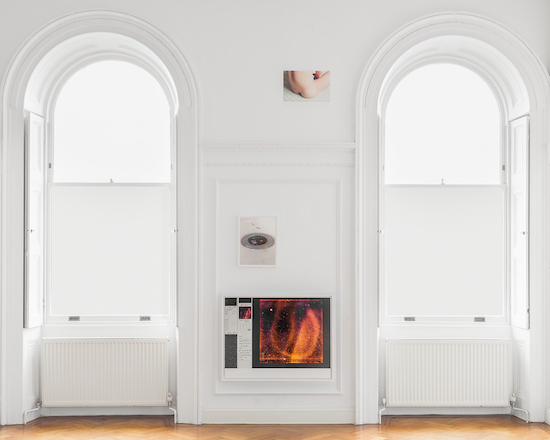Wolfgang Tillmans, Moon in Earthlight, installation view, Morena di Luna, Hove, 2021 © Wolfgang Tillmans, courtesy Maureen Paley, London / Hove
Maureen Paley has a gallery outpost on the South Coast in Regency Hove. The walls are blindingly white in the afternoon sun, the ceilings are high, the fittings original and elegant. Ornate mirrors sit above a large marble fireplace. Wolfgang Tillmans has festooned the walls of two rooms and a corridor space with a large collection of his photographs. They come in different formats and sizes.
One of the most immediately impressive images is Moon in Earthlight (2015). Stylishly, this picture fits neatly between the botanical forms of the cornicing above and the delicate flutings of another fire surround below. Here we see the whole of the moon with a thin sickle of bright sunlight on the right of its circumference. The rest of the entire circle of our only satellite is seen as a duller, greyer globe outlined by light reflected from Earth. You quickly sense there’s an overarching theme at work here: the vastness of everything, the inconceivable expanse of existence, and what’s in it.
Glass fronted cupboards set into the walls are repurposed as vitrines. These directly reference the enormity of our universe as with Vitrine for MDL (Yearbooks 1978-2021) (2021). This is Tillmans on interstellar overdrive and contains a selection of his extensive collection of astronomical texts. The selection of photographs on the walls is studded with imagery from space too. We see galaxies, solar systems and various types of star, the Hale Bopp comet, solar telescopes, and observatories. Another glass cupboard features the more quotidian, the earthbound – as with Fraicheur de Luxe (2021), a selection of images of what people buy from the shops as treats: red things, green things. We ogle and salivate over stuff like Gü puddings, Peruvian lime zillionaire cheesecakes, Waitrose British strawberries, Japanese cucumbers, and Walkers grab bags of ready salted crisps.
There are other stars here more familiar to tQ readers such as Róisín Murphy, Manchester (2019). She holds our gaze and looks cheekily knowing in a red tammy. Then there’s Throbbing Gristle (2005) with a confident Cosey in the foreground blowing her trumpet. Elsewhere Neil Tennant, Vancouver (2016) gives us the besuited Pet Shop Boy musing professorially in a lightbulb heavy dressing room.

Wolfgang Tillmans, Moon in Earthlight, installation view, Morena di Luna, Hove, 2021 © Wolfgang Tillmans, courtesy Maureen Paley, London / Hove
Back to nature: its persistence is a constant here with the accent on plant life and how vegetation is particularly resilient. Two tiny shoots, green and fragile, emerge from the plughole of a kitchen sink in Growth (2020). The tendrils of a tree mimic underground piping and wiring in Root Under the Pavement (2021), a reminder that life will find a way.
Tillmans also mines the surreal sense of disorientation from travel, a pleasure many have missed. An enormous advert for Gillette Fusion blades hangs from a block of apartments in Dubai (2009), the Arabic script weirdly translated as What Crisis? Staying in the Middle East we find pyramids (2005): that odd lower-case spelling alerts us to misalignment and the dizzying prospect of witnessing the mausoleums at Giza set vertically. At first glance this looks like an abstraction, a zigzagging black mass that indents a light grey void. On second viewing, that void resolves itself into sky. But maybe what you see are triangular forms resembling the teeth of a Nile crocodile, or prisms. I’m also reminded of more lunar references – specifically Pink Floyd’s Dark Side of the Moon and its insert design by Hipgnosis with its cobalt blue night shots of the great Egyptian necropolis. Maybe the proximity of Dave Gilmour was having an occult influence on me; he recently renovated a large home on the Hove seafront across the road.

Wolfgang Tillmans, Moon in Earthlight, installation view, Morena di Luna, Hove, 2021 © Wolfgang Tillmans, courtesy Maureen Paley, London / Hove
Tillmans, typically, has installed his work so that forms chime as with the tanned vertebral curves and notches of James’s Spine (2016) set below a desert shot of hills in Chile, Atacama 1 (2012). There are meditations on colour patterning too, as with Reader (2021), where various shades of mauve and lilac Pantone charts are placed over a piece of fabric. This is an attempt to match the shade of another piece of cloth that appears to be bizarrely draped over a duck in a magazine illustration. Why? There’s no why in this world. It just is.
Tillmans’ relentless curiosity – his look at this, now look over here attitude – his enthusiasm, polarises. Some find his remorseless pointing at things suggestive of a sort of attention deficit disorder. But not this viewer. Tillmans is like Paul Whitehouse’s energetic teenager: he’s turned on by the unstoppable amazement of this world. On the BBC’s Fast Show website we’re told that the wacky Whitehouse character digs, amongst other things, “shelves, gravity, holes, yesterday, Ronnie Corbett, holidays, several different types of natural disaster, paint, pavements, the sky, old people, sex, the Romans, shepherds, Jesus, and golf”. That list covers most of what we see on the walls here to a near disturbing extent. Okay Ronnie isn’t in the house, but Bono is.
Tillmans has little of the restraint, the self-imposed restrictions and manipulations that characterise the practice of many of the other famous German photographers around today, in particular those trained under Bernd and Hilla Becher. Like his infamous Man Pissing on a Chair (1997) – not on view here – Tillmans’ incontinence is a deliberately messy affair. He can’t control his interests and ultimately that’s an endearing trait, one that’s likeable, loveable. His work here is a blast of positivity much needed in this drab virally loaded moment. What else can you say? Brilliant!
Wolfgang Tillmans: Moonlight in Earthlight is at Morena di Luna, Hove, until 5 September


